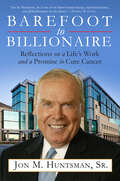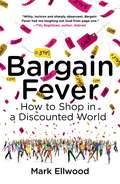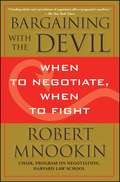- Table View
- List View
Barclays Global Investors and Exchange Traded Funds
by Alison Berkley Wagonfeld Luis M. ViceiraProvides an overview of the Exchange Traded Funds (ETF) industry and highlights the leadership role that Barclays Global Investors (BGI) has played in this developing asset class. BGI launched its first ETFs under the iShares brand name in 2000, and by mid-2007 BGI was the global leader in the $600 billion ETF market. BGI's success had started attracting the interest of other large asset management firms, and Lee Kranefuss, CEO of BGI's iShares business was thinking about how BGI should compete in the increasingly crowded market. Should BGI expand into Europe and Asia more aggressively? Should BGI, already a large manager of 401(k) assets for corporations, pursue the 401(k) market with its iShares products? Would BGI need to cut its fees as other competitors such as Vanguard started marketing its "low-cost" ETF products?
Barclays and the LIBOR Scandal
by Aldo Sesia Clayton RoseIn June of 2012, Barclays plc admitted that it had manipulated the London Interbank Offered Rate (LIBOR)-a benchmark interest rate that was fundamental to the operation of international financial markets and that was the basis for trillions of dollars of financial transactions. Between 2005 and 2009, Barclays, one of the world's largest and most important banks, manipulated LIBOR to gain profits and/or limit losses from derivative trades. In addition, between 2007 and 2009, the firm had made dishonestly low LIBOR submission rates to dampen market speculation and negative media comments about the firm's viability during the financial crisis. In settling with U.K. and U.S. regulators the firm agreed to pay $450 million in fines. Within a few days of the settlement, Barclays' CEO, Robert Diamond, had resigned under pressure from British regulators. Diamond blamed a small number of employees for the derivative trading-related LIBOR rate violations and termed their actions as "reprehensible." As for rigging LIBOR rates to limit market and media speculation of Barclays' financial viability, Diamond denied any personal wrongdoing, and argued, that if anything, Barclays was more honest in its LIBOR submissions than other banks-questioning how banks that were so troubled as to later be partly nationalized could appear to borrow at a lower rate than Barclays. This case explains why LIBOR was an essential part of the global financial market, the mechanism used to establish the rate, and what Barclays did wrong. The case allows for an examination of: i) the consequences of violating the trust of market participants, ii) cultural and leadership flaws at Barclays; iii) the challenge of effectively competing in a market where systemic, and widely understood, corruption is taking place, iv) the complicity of regulators in perpetuating a corrupt system; v) what might, or might not, be effective remedies for the systemic flaws in LIBOR
Barco Projection Systems (A): Worldwide Niche Marketing
by Rowland T. Moriarty Jr. Krista McquadeDeals with the issue of niche marketing in a worldwide market. Barco Projection Systems makes video, data, and graphics projectors for the industrial market. They have traditionally been the performance leader. In August 1989, Sony Corp. introduced a higher performance graphics projector at a considerably lower price than Barco's existing projector. As a result, Barco is faced with being preempted in their fastest growing segment by a competitor with much larger resources. Deals with how a small niche player deals with considerably larger competitors in a global environment.
Barco Projection Systems (B)
by Rowland T. Moriarty Jr. Krista McQuadeUpdates Barco Projection Systems (A).
Barco Projection Systems (B)
by Rowland T. Moriarty Jr. Krista McquadeUpdates Barco Projection Systems (A).
Barco Projection Systems (C)
by Rowland T. Moriarty Jr. Krista McQuadeUpdates Barco Projection Systems (B).
Barco Projection Systems (C)
by Rowland T. Moriarty Jr. Krista McquadeUpdates Barco Projection Systems (B).
Barco Projection Systems (D)
by Rowland T. Moriarty Jr. Krista McQuadeUpdates Barco Projection Systems (C).
Barco Projection Systems (D)
by Rowland T. Moriarty Jr. Krista McquadeUpdates Barco Projection Systems (C).
Bare Knuckle People Management: Creating Success with the Team You Have - Winners, Losers, Misfits, and All
by John Kulisek Sean O'NeilOne of the biggest challenges for new managers is how to get the best out of each of their team members so they achieve superior results—and make you, the new manager, look good! In Bare Knuckle People Management authors Sean O'Neil and John Kulisek cut through the crap to show managers how to push their teams to success, not by following fluffy leadership training but by using the skills that got them promoted in the first place. Forget kumbayas or one-minute managing. The best people managers know that approaches that work great with one employee will be lost on the next. With the same irreverent and straightforward style they use in their management training workshops, O'Neil and Kulisek describe the 16 basic worker types you must learn to recognize, from The Badass to The Burnout, and how to customize your leadership style for each type. The authors encourage the readers to take pieces of what works from each of the sections and they also remind them to follow the gut instinct that got them to their new management position in the first place. Written in short, easily digestible sections, and both entertaining and insightful throughout, Bare Knuckle People Management is perfect for any manager pressed for time and in need of some straightforward advice.
Barefoot Doctors and Medical Tourists: Futile Attempts to Confront the Grim Reaper--The State of Health Care in China and India
by Tarun KhannaThis chapter looks at the turmoil and deep inequity of the health care systems in China and India, where great divides in medical access exist between rural and urban areas.
Barefoot to Billionaire: Reflections on a Life's Work and a Promise to Cure Cancer
by Jon HuntsmanAn inspiring autobiography by &“one of the finest human beings, industrial leaders, and philanthropists on the planet&” (Stephen R. Covey). The company Jon Huntsman founded in 1970, the Huntsman Corporation, is now one of the largest petrochemical manufacturers in the world, employing more than 12,000 people and generating over $10 billion in revenue each year. Success in business, though, was always a means to an end for him—never an end in itself. In Barefoot to Billionaire, Huntsman revisits the key moments in his life that shaped his view of faith, family, service, and the responsibility that comes with wealth. He writes candidly about his brief tenure in the Nixon administration, which preceded the Watergate scandal but still left a deep impression on him about the abuse of power and the significance of personal respect and integrity. He also opens up about his faith and prominent membership in the Church of Jesus Christ of Latter-day Saints. But most importantly, Huntsman reveals the rationale behind his commitment to give away his entire fortune before his death. In 1995, Huntsman and his wife, Karen, founded the Huntsman Cancer Institute and eventually dedicated more than a billion dollars of their personal funds to the fight for a cure. In this increasingly materialistic world, Barefoot to Billionaire is a refreshing reminder of the enduring power of traditional values.
Bargain Fever
by Mark EllwoodA spirited investigation into the world of bargain hunting and how shoppers and sellers try to one-up each other When Coca-Cola offered the first retail coupon in the 1880s, customers were thrilled. But today, one in four American shoppers will buy something only if it’s on sale, and almost half of all merchandise carries a promotional price. The relentless pursuit of deals has totally disrupted the relationship between buyers and sellers. In this playful, well-researched book, journalist Mark Ellwood investigates what happens to markets when everything’s negotiable. From the haggling bazaars of Istanbul to Black Friday at a mall in upstate New York to pinnacles of global luxury such as Hermès and Louis Vuitton, sellers and shoppers are engaged in a constant game of cat and mouse. Price consultants use the latest findings in neuroeconomics to fool shoppers into thinking they’ve gotten a great deal. Consumers, on the other hand, are more empowered than ever by technology, from coupon apps to strategic Twitter analysis. And some brands resist the trend entirely, opting to set their unsold merch out to sea and shred it rather than slash prices. Enlightening as it is entertaining, Bargain Fever offers invaluable insights into how shopping works today. .
Bargain Fever
by Mark EllwoodDiscounts are no longer the exception, they're the norm. But is that bargain really a bargain? Paying full price is so passé. A quarter of the population will only open their wallets if something is on sale. Everyone wants a deal, a steal, a hookup with a discount or a way to cut costs. People don't only want a deep discount, they expect it and won't settle for anything less. They're lucky, then, that almost half of everything sold in America is listed at some kind of promotional price. It's a seismic shift that has made shoppers more savvy than ever, generating phenomena like extreme couponing, flash sales, and Groupon. So there's never been a better time to be a buyer, right? Perhaps. Sellers have developed their own tricks to protect profit margins amid such markdown mania--ones that include secret sales, shifting prices, and shredding perfectly good clothes. In this playful, deeply researched book, journalist Mark Ellwood takes a trip into this new landscape. He shows how some people are, quite literally, born to be bargain junkies thanks to a quirk of their DNA, and uncovers the sales-driven sleights of hand that sellers employ to hoodwink unsuspecting buyers. Ellwood takes us from the floor of upscale department store Bergdorf Goodman to the bustling aisles of a Turkish bazaar, from the outlet Disney world of rural Pennsylvania to a town in Florida that can claim to be couponing's spiritual capital. We meet savvy buyers trying to wring value from every cent--stalking fashion editors' tweets to learn about sample sales or camping out overnight for a cut-price computer. Ellwood also uncovers the dark side of discounting: how organized crime steals coupons en masse and how certain boutiques limit discounts to VIPs, running secret sticker promotions from which the ordinary shopper is excluded. Bargain Fever is a manual for thriving in this new era, when deal hunting has gone from being a sign of indigence to one of intelligence. There's never been a better time to be a buyer--at least if you know how the game works.
Bargaining Strategies: Collaborative vs. Competitive Approaches
by James P. WareNote describes aspects of bargaining situations that point toward either collaborative or distributive bargaining strategies. Focuses on the nature of the issues, the relationship between the negotiators, and broader contextual factors, and how these variables influence the negotiation climate. Also describes tactics for bargaining effectively in mixed situations that call for both kinds of strategies.
Bargaining With The Devil
by Robert MnookinThe art of negotiation--from one of the country's most eminent practitioners and the Chair of the Harvard Law School's Program on Negotiation.
Bargaining for Advantage: Negotiation Strategies for Reasonable People
by Shell G. RichardAs director of the renowned Wharton Executive Negotiation Workshop, Professor G. Richard Shell has taught thousands of business leaders, administrators, and other professionals how to survive and thrive in the sometimes rough-and-tumble world of negotiation. His systematic, step-by-step approach comes to life in this book, which is available in over ten foreign editions and combines lively storytelling, proven tactics, and reliable insights gleaned from the latest negotiation research. This updated edition includes: A brand-new "Negotiation I. Q. " test designed by Shell and used by executives at the Wharton workshop that reveals each reader's unique strengths and weaknesses as a negotiator A concise manual on how to avoid the perils and pitfalls of online negotiations involving e-mail and instant messaging A detailed look at how gender and cultural differences can derail negotiations, and advice for putting talks back on track .
Bargaining for Eden: The Fight for the Last Open Spaces in America
by Stephen TrimbleThis book takes a penetrating look at the battles raging over the land--and the soul--of the American West and investigates the story of a reclusive billionaire who worked relentlessly to acquire public land for his ski resort and to host the Salt Lake City Winter Olympics. Trimble explores the inner conflicts, paradoxes, and greed at the heart of land-use disputes from the back rooms of Washington to the grassroots efforts of passionate citizens.
Bargaining: Current Research and Future Directions
by Emin Karagözoğlu Kyle B. HyndmanThis Edited Collection provides a rigorous and rich overview of current bargaining research in economics and related disciplines, as well as a discussion of future directions. The Editors create cross-disciplinary and cross-methodological synergies by bringing together bargaining researchers from various fields, including game theory, experimental economics, political economy, autonomous negotiations, artificial intelligence, environmental economics and behavioral operations management; as well as using various methods, including the strategic approach, axiomatic approach, empirical research, lab and field experiments, machine learning and decision support systems. Offering insights into the theoretical foundations of bargaining research, traditional applications to bargaining research and topics of growing importance due to new advances in technology and the changing political and physical landscape of the world, this book is a key tool for anyone working on or interested in bargaining.
Baria Planning Solutions, Inc.: Fixing the Sales Process
by Steven C. Wheelwright William SchmidtBaria Planning Solutions (BPS) is a consulting firm that specializes in using spend analysis to help companies identify savings through reduced procurement costs and improved supplier performance. Management is concerned about the disappointing performance of the sales team in attaining new clients and renewing existing ones. The Sales directors feel they do not get the help they need from Sales Support to close new deals, while the Sales Support directors believe they could provide better support by organizing into industry-specific divisions. The consulting industry is becoming increasingly competitive and inefficiencies in the sales process at BPS may interfere with the company's ability to win new business. The recently hired director of North American Sales Support must analyze the current process flow for Sales Support and identify the problems facing the sales organization. The president of the company has asked her to present a proposal for improving the performance of the entire group.
Baria Planning Solutions, Inc.: Fixing the Sales Process
by Steven C. Wheelwright William SchmidtBaria Planning Solutions (BPS) is a consulting firm that specializes in using spend analysis to help companies identify savings through reduced procurement costs and improved supplier performance. Management is concerned about the disappointing performance of the sales team in attaining new clients and renewing existing ones. The Sales directors feel they do not get the help they need from Sales Support to close new deals, while the Sales Support directors believe they could provide better support by organizing into industry-specific divisions. The consulting industry is becoming increasingly competitive and inefficiencies in the sales process at BPS may interfere with the company's ability to win new business. The recently hired director of North American Sales Support must analyze the current process flow for Sales Support and identify the problems facing the sales organization. The president of the company has asked her to present a proposal for improving the performance of the entire group.
Barilla SpA (A)
by Janice H. HammondBarilla SpA, an Italian manufacturer that sells to its retailers largely through third-party distributors, experienced widely fluctuating demand patterns from its distributors during the late 1980s. This case describes a proposal to address the problem by implementing a continuous replenishment program, under which the responsibility for determining shipment quantities to the distributors would shift from the distributors to Barilla. Describes support and resistance within Barilla's different functional areas and within the distributors Barilla approached with the proposal.







